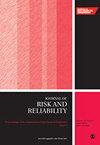A virtual reality instrument to raise drivers’ awareness on safer driving through road tunnels
IF 1.8
4区 工程技术
Q3 ENGINEERING, INDUSTRIAL
Proceedings of the Institution of Mechanical Engineers Part O-Journal of Risk and Reliability
Pub Date : 2023-05-25
DOI:10.1177/1748006x231175719
引用次数: 0
Abstract
Studies reveal that drivers’ behavior is the most significant factor in road accidents worldwide. Regarding tunnels, which are the most critical element of road infrastructure, despite the significant efforts that have been conducted toward the enhancement of drivers’ education all these years, studies illustrate that there are still serious deficiencies need to be tackled. To address this issue, this research endeavor develops a virtual reality tool based on the serious game idea in order to inform and educate potential users about the specific rules and behavioral patterns that should govern their safe driving when passing through tunnels. To do so, the appropriate behavioral patterns are determined using applicable norms and guidelines while the specific educational requirements are identified. Following that, the novel tool for training users is developed. The tool consists of a virtual reality gaming environment based on the notion of serious games that simulates driving through a tunnel from a first-person perspective. Various scenarios are developed within this environment based on the knowledge gaps identified in the literature, with the aim of assessing users’ knowledge as well as educating them when required. The developed tool was tried by more than 50 drivers, professional and non-professional during tool’s launch activities. In particular, drivers who had recently obtained a driver’s license confirmed that such a tool would be especially useful in the context of their training. The ultimate goal of this study is to provide an efficient tool in order to support both practitioners and authorities to significantly improve the safety level of road tunnels by emphasizing on the driving behavior, since this is considered the most crucial component of each tunnel system.一种虚拟现实仪器,提高驾驶员在道路隧道中安全驾驶的意识
研究表明,司机的行为是世界范围内道路交通事故的最重要因素。隧道是道路基础设施中最重要的组成部分,尽管这些年来在加强驾驶员教育方面做出了重大努力,但研究表明,仍有严重的不足需要解决。为了解决这个问题,本研究努力开发了一个基于严肃游戏理念的虚拟现实工具,以告知和教育潜在用户在通过隧道时应该管理他们安全驾驶的具体规则和行为模式。为此,使用适用的规范和指导方针确定适当的行为模式,同时确定具体的教育要求。随后,开发了用于培训用户的新型工具。该工具由基于严肃游戏概念的虚拟现实游戏环境组成,以第一人称视角模拟驾驶通过隧道。根据文献中确定的知识差距,在这个环境中开发了各种场景,目的是评估用户的知识,并在需要时对他们进行培训。开发的工具在工具发布活动中由50多名专业和非专业司机试用。特别是,最近获得驾驶执照的司机证实,这种工具在他们的培训中特别有用。本研究的最终目标是提供一个有效的工具,以支持从业者和当局通过强调驾驶行为来显着提高道路隧道的安全水平,因为这被认为是每个隧道系统中最重要的组成部分。
本文章由计算机程序翻译,如有差异,请以英文原文为准。
求助全文
约1分钟内获得全文
求助全文
来源期刊

Proceedings of the Institution of Mechanical Engineers Part O-Journal of Risk and Reliability
ENGINEERING, MULTIDISCIPLINARY-ENGINEERING, INDUSTRIAL
CiteScore
4.50
自引率
19.00%
发文量
81
审稿时长
6-12 weeks
期刊介绍:
The Journal of Risk and Reliability is for researchers and practitioners who are involved in the field of risk analysis and reliability engineering. The remit of the Journal covers concepts, theories, principles, approaches, methods and models for the proper understanding, assessment, characterisation and management of the risk and reliability of engineering systems. The journal welcomes papers which are based on mathematical and probabilistic analysis, simulation and/or optimisation, as well as works highlighting conceptual and managerial issues. Papers that provide perspectives on current practices and methods, and how to improve these, are also welcome
 求助内容:
求助内容: 应助结果提醒方式:
应助结果提醒方式:


